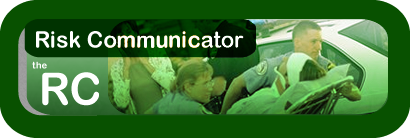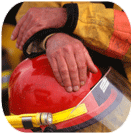The Risk Communicator Newsletter

Providing information and resources to help emergency risk communicators prepare and effectively respond in the event of a crisis.
Program Spotlight: On the Frontlines of the California Wildfires
During a crisis, disaster, or emergency stakeholders play an essential role in reaching the public with life-saving information. Knowing their concerns and needs is just as important as knowing those of public audiences.
As the nation watched the California wildfires response efforts, Terri Stratton, MPH, Chief, Risk Communication and Professional Training Section, Emergency Preparedness Office, California Department of Public Health (CDPH), was on the frontlines. She recently shared with The RC how she and her team were able to address two likely concerns of their stakeholders: inclusion in the decision-making process and access to information. Relationships built during pre-event planning were also pivotal to successful response efforts. In addition to developing its communication plan, the act of planning itself enabled CDPH to build key relationships and better anticipate stakeholders' needs during a real emergency.
The Risk Communicator: When did you first learn of the wildfires?
Terri Stratton (TS): When I arrived in the office on Monday morning, October 22, I was notified of a briefing and the intent to open our department's Joint Emergency Operations Center (JEOC).
RC: What were the first steps you took?
TS: I activated our Risk Communication protocols, which involves notification of our response partners including the California Office of Emergency Services Public Information Officer (PIO). I assembled my team and reported to our JEOC and assigned roles to the team to include Web support, public information materials, fact sheets, and press releases. I also arranged for CDPH PIO staff to report to the State Operations Center Joint Information Center (JIC) to support the public health information aspects.
We utilized our Crisis and Emergency Risk Communication Tool Kit for procedures, protocols, and template materials. Via the California Health Alert Network (CAHAN), we shared press release templates addressing health concerns regarding smoke with affected local public health departments and issued similar press releases from CDPH. We scheduled calls with local health department PIOs and risk communication leads to share information and to find out what support they needed.
We communicated with the CDC Emergency Communications System (ECS) and shared requests from locals for translation support. Requests for translation of smoke- and ash-related fact sheets and press release templates were divided between CDPH and CDC ECS to expedite the request process. Our team participated in daily fire briefing calls and represented public information with state and local partners. We scheduled and held daily conference calls with PIOs from the affected southern counties, CDC's ECS, and the National Red Cross for status update and support for local messaging.
CDPH provided staff support to the State Operations Center (SOC) JIC for public health interface and messaging. We proactively continued pushing out information through press releases and the web while sharing with local health departments and the state JIC for more than a week. We responded to requests for new information regarding masks through collaboration with CDPH subject matter experts. Media monitoring and rumor control provided leadership in developing forward-thinking messages and distributing information to the public when media started looking for someone to blame (government/local officials) for the extent of the fires.
RC: What went right during the response?
TS: Pre-planning, a uniformed approach, and established relationships with partners all greatly facilitated the effective response.
RC: Were there any challenges?
TS: Yes, the California Office of Emergency Services was without a permanent PIO and the person filling in was very unfamiliar with their system as well as ours. Support was pulled in from other agencies and departments. A couple of days into the response the Governor's Office assumed control over the release of all fire-related messages. This hampered our ability to directly disseminate health-specific press releases.
RC: Did you employ any lessons learned from Katrina or other crisis events?
TS: Absolutely. We utilized lessons learned from Katrina and the 2003 Southern California fires. Special emphasis was placed on communicating with special populations, providing translated information, partnering with local agencies, and utilizing immediate shelters short term. We also used recommendations shared at the 2006 CDPH Best Practices in Risk Communication Summit.
RC: What advice would you give to others?
TS: Plan, plan, plan with partners and then test and refine plans. Build relationships to facilitate rapid and consistent communication, and train partners on protocols, resources, approaches, and tools and then utilize.
When faced with inevitable communication challenges during a crisis, the California wildfires spotlight demonstrates the importance of knowing public and stakeholder audiences, and in being flexible as their needs change. As in many emergencies, working with and through stakeholders enabled CDPH to reach people with consistent messages, appropriately tailored in delivery and design, through a larger number of and more diverse communication channels.
During a crisis, disaster, or emergency stakeholders play an essential role in reaching the public with life-saving information. Knowing their concerns and needs is just as important as knowing those of public audiences.
As the nation watched the California wildfires response efforts, Terri Stratton, MPH, Chief, Risk Communication and Professional Training Section, Emergency Preparedness Office, California Department of Public Health (CDPH), was on the frontlines. She recently shared with The RC how she and her team were able to address two likely concerns of their stakeholders: inclusion in the decision-making process and access to information. Relationships built during pre-event planning were also pivotal to successful response efforts. In addition to developing its communication plan, the act of planning itself enabled CDPH to build key relationships and better anticipate stakeholders' needs during a real emergency.
The Risk Communicator: When did you first learn of the wildfires?
Terri Stratton: When I arrived in the office on Monday morning, October 22, I was notified of a briefing and the intent to open our department's Joint Emergency Operations Center (JEOC).
RC: What were the first steps you took?
TS: I activated our Risk Communication protocols, which involves notification of our response partners including the California Office of Emergency Services Public Information Officer (PIO). I assembled my team and reported to our JEOC and assigned roles to the team to include Web support, public information materials, fact sheets, and press releases. I also arranged for CDPH PIO staff to report to the State Operations Center Joint Information Center (JIC) to support the public health information aspects.
We utilized our Crisis and Emergency Risk Communication Tool Kit for procedures, protocols, and template materials. Via the California Health Alert Network (CAHAN), we shared press release templates addressing health concerns regarding smoke with affected local public health departments and issued similar press releases from CDPH. We scheduled calls with local health department PIOs and risk communication leads to share information and to find out what support they needed.
We communicated with the CDC Emergency Communications System (ECS) and shared requests from locals for translation support. Requests for translation of smoke- and ash-related fact sheets and press release templates were divided between CDPH and CDC ECS to expedite the request process. Our team participated in daily fire briefing calls and represented public information with state and local partners. We scheduled and held daily conference calls with PIOs from the affected southern counties, CDC's ECS, and the National Red Cross for status update and support for local messaging.
CDPH provided staff support to the State Operations Center (SOC) JIC for public health interface and messaging. We proactively continued pushing out information through press releases and the web while sharing with local health departments and the state JIC for more than a week. We responded to requests for new information regarding masks through collaboration with CDPH subject matter experts. Media monitoring and rumor control provided leadership in developing forward-thinking messages and distributing information to the public when media started looking for someone to blame (government/local officials) for the extent of the fires.
RC: What went right during the response?
TS: Pre-planning, a uniformed approach, and established relationships with partners all greatly facilitated the effective response.
RC: Were there any challenges?
TS: Yes, the California Office of Emergency Services was without a permanent PIO and the person filling in was very unfamiliar with their system as well as ours. Support was pulled in from other agencies and departments. A couple of days into the response the Governor's Office assumed control over the release of all fire-related messages. This hampered our ability to directly disseminate health-specific press releases.
RC: Did you employ any lessons learned from Katrina or other crisis events?
TS: Absolutely. We utilized lessons learned from Katrina and the 2003 Southern California fires. Special emphasis was placed on communicating with special populations, providing translated information, partnering with local agencies, and utilizing immediate shelters short term. We also used recommendations shared at the 2006 CDPH Best Practices in Risk Communication Summit.
RC: What advice would you give to others?
TS: Plan, plan, plan with partners and then test and refine plans. Build relationships to facilitate rapid and consistent communication, and train partners on protocols, resources, approaches, and tools and then utilize.
When faced with inevitable communication challenges during a crisis, the California wildfires spotlight demonstrates the importance of knowing public and stakeholder audiences, and in being flexible as their needs change. As in many emergencies, working with and through stakeholders enabled CDPH to reach people with consistent messages, appropriately tailored in delivery and design, through a larger number of and more diverse communication channels.
- Page last updated May 22, 2010
- Page last reviewed May 22, 2010
- Content source: Office of Public Health Preparedness & Response (OPHPR) > Division of Emergency Operations (DEO) > Emergency Risk Communication Branch (ERCB)xxxx
Get email updates
To receive email updates about this page, enter your email address:
Contact Us:
- Centers for Disease Control and Prevention
1600 Clifton Rd
Atlanta, GA 30333 - 800-CDC-INFO
(800-232-4636)
TTY: (888) 232-6348 - Contact CDC-INFO



